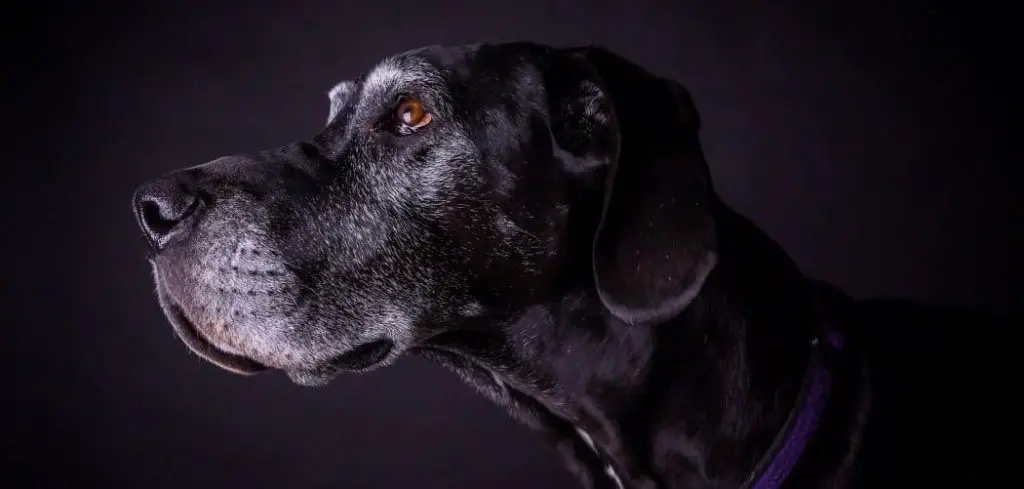It can be unsettling to see your senior dog standing silently and staring at night, seemingly without reason.
This behavior may be more than just a quirk and could indicate underlying medical issues.
Understanding why your old dog engages in this nighttime behavior helps you determine whether it’s harmless or a sign that veterinary attention is needed.
We outline the common reasons for an old dog just standing and staring at night, what you can do at home, and when to seek veterinary help.
Table of Contents
Old Dog Just Standing and Staring at Night — Why It Happens
Nighttime staring in older dogs can result from a combination of cognitive, sensory, and physical factors. Age-related vision or hearing changes, cognitive decline, and neurological issues can lead to prolonged periods of standing and staring. Pain, discomfort, or underlying medical conditions such as arthritis or urinary problems may also contribute.
Monitoring your dog’s overall behavior and daily routine can help distinguish normal aging from concerning symptoms that require attention.

Old Dog Just Standing and Staring at Night: Common Causes
Cognitive Dysfunction
Cognitive dysfunction syndrome (CDS), similar to dementia in humans, affects some senior dogs.
Dogs with CDS may experience confusion, disorientation, and changes in sleep-wake cycles. Nighttime staring or pacing is common, along with restlessness, vocalization, or altered interactions with family members.
Early diagnosis and environmental adjustments can help manage symptoms and improve comfort.
Read more: Old Dog Standing and Staring (What It Means)
Vision or Hearing Loss
Age-related decline in sight or hearing can make a dog appear alert and focused while standing and staring.
Reduced vision may cause hesitation, while diminished hearing can make them more aware of subtle environmental sounds.
Dogs may stand still, seemingly staring, as they process sensory input or compensate for deficits. Ensuring a safe environment and maintaining routines can ease anxiety and prevent injury.
Pain or Discomfort
Chronic pain from arthritis, joint stiffness, or other conditions can result in unusual standing behavior.
Dogs may stand and stare to relieve pressure on painful areas or avoid movement that exacerbates discomfort.
Other signs may include limping, difficulty lying down, or whimpering. Veterinary pain management and supportive bedding can significantly improve their quality of life.
Neurological Disorders
Seizure disorders, vestibular disease, or other neurological issues can alter posture and attention.
Standing and staring may precede a seizure, be part of a vestibular episode, or reflect disorientation from nerve dysfunction.
Signs can include head tilting, loss of balance, circling, or sudden falls. Prompt veterinary evaluation is crucial to prevent injury and identify treatable conditions.
Urinary or Gastrointestinal Issues
Discomfort from urinary tract infections, constipation, or other gastrointestinal problems can cause unusual behaviors.
Dogs may stand and stare at night as they feel the urge to urinate or defecate but are hesitant to move.
Other indications may include accidents in the house, frequent trips to the litter area, or straining. Addressing the underlying issue can relieve discomfort and reduce disruptive behaviors.
Anxiety or Stress
Nighttime anxiety, separation anxiety, or environmental stressors can trigger standing and staring.
Dogs may appear tense, alert, or focused on areas of the room, sometimes accompanied by pacing or vocalizations.
Creating a calm, predictable environment with comforting bedding and night lighting can help alleviate anxiety.
What to Do If Your Old Dog Is Just Standing and Staring at Night
Observe and document patterns, noting timing, duration, and any other behaviors or vocalizations.
Ensure your dog has a comfortable, safe sleeping area with supportive bedding and accessible water.
Maintain a consistent nighttime routine to reduce stress, including a short evening walk and calming activities.
Address potential medical or pain-related issues with your veterinarian, including joint support, urinary health, and vision or hearing checks.
Provide gentle mental stimulation during the day to keep your dog engaged, which may reduce nighttime restlessness.
When to Call or Visit Your Vet
Seek veterinary care if your dog suddenly starts standing and staring at night, especially with confusion, disorientation, or sudden behavior changes.
Immediate attention is necessary if signs of pain, difficulty moving, labored breathing, or vocal distress are present.
Persistent or worsening nighttime staring accompanied by accidents in the house, vomiting, or lethargy should be evaluated promptly.
Routine veterinary checkups are recommended to assess cognitive function, sensory health, and underlying medical conditions in senior dogs.
Read more: Old Dog Just Standing and Staring and Shaking (Here’s Why)
Key Takeaway
Nighttime standing and staring in older dogs may be a normal part of aging, but it can also indicate cognitive dysfunction, sensory decline, pain, neurological issues, or anxiety.
Observing your dog’s overall behavior, providing a safe and comfortable environment, and consulting your veterinarian are crucial steps in ensuring their health and well-being.
Early detection and proactive care can address underlying medical conditions, reduce discomfort, and improve your senior dog’s quality of life.
With patience, attention, and professional guidance, you can help your dog navigate their golden years with comfort and security.
